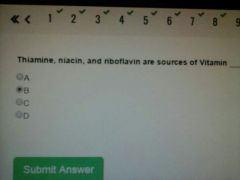![]()
![]()
![]()
Use LEFT and RIGHT arrow keys to navigate between flashcards;
Use UP and DOWN arrow keys to flip the card;
H to show hint;
A reads text to speech;
55 Cards in this Set
- Front
- Back
- 3rd side (hint)
|
From all the available foods, we should select what of each? |
The proper balance |
|
|
|
My Plate includes which five food groups? |
Fruits, vegetables, grains, protein and dairy |
|
|
|
Grains have the most what? |
Carbohydrates |
|
|
|
Iodine is a? |
Mineral |
|
|
|
A well-recognized group of diseases is known as? |
Deficiency diseases |
|
|
|
Cereals, bread, and pastas are examples of what? |
Grains |
|
|
|
What will prevent scurvy? |
Raw Vegetables |
|
|
|
Oily veggies or animal substances are examples of? |
Fats |
|
|
|
Carbohydrates are nutrients that provide? |
Quick energy |
|
|
|
Meat, fish, cheese, and peas have? |
Proteins |
|
|
|
Are calcium and iron vitamins? |
No |
|
|
|
Vitamin A |
Keeps eyes, skin, and hair healthy. |
|
|
|
Vitamin A found in what? |
Fatty foods, milk, butter, and Carotene |
|
|
|
Vitamin B |
Helps Nervous system function |
|
|
|
Vitamin C |
Helps form blood vessels, prevents scurvy, resists infection |
|
|
|
Vitamin D |
Builds calcium and phosphorus into bones |
|
|
|
Vitamin E |
Helps cells function normally |
|
|
|
Vitamin K |
Helps blood clot |
|
|
|
Good source of vitamin B |
Leafy vegetables |
|
|
|
Bruising, bleeding into tissues are symptoms of lack of which vitamin? |
Vitamin C called scurvy |
|
|
|
Partial blindness and infections is lack of which vitamin? |
Vitamin A |
|
|
|
Sources of vitamin B |

Thiamine, niacin, riboflavin |
|
|
|
How does toxic waste enter foods? |
Through the contamination of groundwater |
|
|
|
"Junk food" refers to food made mostly of what? |
Fats and sugars |
|
|
|
Two common symptoms of allergic reaction that affect the brain are what? |
Headache and fatigue |
|
|
|
Pasteurization |
Process of heating a substance to kill harmful microbes but leave the flavor unharmed |
|
|
|
Vaccines |
Substances of dead or weak bacteria introduced into the body to produce resistance to a specific disease |
Its ok |
|
|
Contagious |
Easily transferred from person to person by direct or indirect contact |
|
|
|
Antiseptic |
Chemical that slows down or stops bacteria growth |
|
|
|
Germ |
Microscopic organism (microbes) |
|
|
|
Bacteria |
Microscopic organism that does not have a nucleus and multiplies by single cell division |
|
|
|
Microscopic |
Requiring a microscope to view because of very small size |
|
|
|
Hygiene |
The system of habits used to preserve good health |
|
|
|
Who had the idea that diseases are the result of germs? |
Louis Pasteur |
|
|
|
What is the easiest and first defense against contagious diseases? |
Sanitation |
|
|
|
What is the top layer of skin called? |
Epidermis |
|
|
|
What is the second layer of skin called? |
Dermis |
|
|
|
The dermis contains what? |
Our sweat and oil glands |
|
|
|
The epidermis contains what? |
Our skin cells |
|
|
|
Nervous stress can contribute to and cause what? |
Skin blemishes |
|
|
|
Where does oil and sweat accumulate the most because skin is very active? |
Scalp |
|
|
|
Our growth and size are primarily linked to what? |
Genetics |
|
|
|
What keeps muscles tone and strengthens the heart? |
Exercise!!! |
|
|
|
Many plants, rocks, soil and water contain what? |
Minerals |
|
|
|
Amino acids are what? |
Building blocks for proteins |
|
|
|
Healthy bones, teeth and muscles need which mineral? |
Calcium |
|
|
|
What are pesticides? |
Chemicals used to get rid of insects from crops |
|
|
|
What is a preservative? |
Chemical that is added to food to stop it from spoiling |
|
|
|
An lack of vitamin B can cause which disease? |
Beriberi |
|
|
|
An extreme lack of vitamin C can cause which disease? |
Scurvy |
|
|
|
What is plaque? |
A sticky substance that forms in or on teeth from bacteria |
|
|
|
Which disease is caused by an extreme lack of vitamin D? |
Rickets |
|
|
|
List the 4 steps of digestion in order : |
1. Carbs change to sugar 2. Protein breaks down to amino acids 3. Fats convert to fatty acids 4. Nutrients are carried to cells |
|
|
|
Evaporation from your body helps control proper ...? |
Body Temperature |
|
|
|
You need to be able to label the schematic digestive system from quiz 1 question 15. |
Mouth, esophagus, liver, gall bladder, stomach, pancreas, large intestine and small intestine |
|

